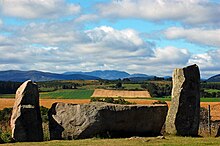Tomnaverie
Tomnaverie (formerly called Tom-na-hivrigh) is a stone circle of the Recumbent Stone Circle (RSC) type, which is widespread in the Grampian region , especially on the Dee, with almost 100 specimens. A characteristic of the RSC is a "lying stone" accompanied by two standing, high, often tapering "flank stones", which are located on the periphery of the circle or near the circle. Tomnaverie is located on a hill (Hill of Worship or Justice) 1.2 km southeast of Tarland in Aberdeenshire in Scotland . The stone circle was built between 1800 and 1600 BC. Erected, parts of the complex are older.
Monument history
The primary function of Tomnaverie was that of a pyre, which was then enclosed by a ring cairn and finally surrounded by the stone circle. The treatment of the dead was only one element of the ritual practice in these places.
Research history
The stone circle was first described in 1792. During the 19th and early 20th centuries , stones were quarried from the granite quarry on which the circle is located for the houses on Main Street and the Victorian market square in Tarland. The two flank stones (2.8 and 2.2 m high) made of red granite and the 12.5 t “lying stone”, 3.1 m long, were overturned. The mining activities also caused the loss of two circle stones, several had fallen over and only four were standing upright. After the restoration there are ten. The RSC was excavated in 1999 by Richard Bradley (born 1946) and restored in 2000.
construction
The circle has a diameter of about 18.0 m. The remains of a Ringcairn, similar to that of Nine Stanes, lie within the circle. The Ringcairn was held in place by an outer ring made of curb stones and is around 14 m in diameter. In Tomnaverie, as in Eslie the Greater , Nine Stanes and Clune Wood, the dormant stones are in the southeast. The construction of the stones was preceded by a phase during which several stone-lined mounds were built that contained corpse burns. In the end, the place was used as a cremation burial ground.
The stone circles on the River Dee
The Deeside Stone Circles form a group of Recumbent Stone Circles (RSC). About 100 of them were born between 2500 and 1500 BC. In Aberdeenshire. The ensembles of the "resting stones" are usually in the southeast and (usually) on the course of the ring.
Individual evidence
- ^ Richard Bradley: The Moon and the Bonfire. An investigation of three stone circles in north-east Scotland. Society of Antiquaries of Scotland, Edinburgh 2005, p. Xi, ISBN 0-903903-33-4 .
literature
- Richard Bradley: The Moon and the Bonfire. An investigation of three stone circles in north-east Scotland. Edinburgh, Society of Antiquaries of Scotland 2005, ISBN 0-903903-33-4 .
- A. Welfare: Great Crowns of Stone. RCAHMS, 2011
- C. Richards: Building the Great Stone Circles of the North. Windgather Press, 2013
Web links
- Entry on Tomnaverie in Canmore, Historic Environment Scotland's database
- Description + pictures, Megalithics.com
- Description + pictures
- Description + pictures
- Description + pictures
Coordinates: 57 ° 7 '10.9 " N , 2 ° 50' 59.7" W.


